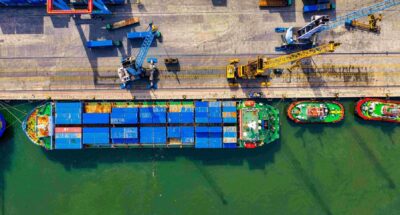
India is ready to play key role in an emerging new world order
Mridul Kumar, India’s ambassador to Switzerland, gives his personal view of his nation’s growing role as a leader in a multipolar world....
Audio available

by Simon J. Evenett Published April 3, 2025 in Geopolitics • 7 min read
On 2 April, the United States introduced what is arguably the most far-reaching shift in its trade policy since the early 20th century. The measures – anchored in a new executive order – are triggered by a determination that large and persistent US goods trade deficits are a national security risk. In response, the administration has imposed substantial tariff increases on imports from more than 60 countries.
Unlike earlier interventions targeting specific nations or products, this approach is generalized and mechanistic. The scale of a country’s trade surplus with the United States now determines the tariff level it faces. A baseline 10% additional tariff applies to nearly all trade partners; for some, the increase is markedly higher.Switzerland faces a 31% rise in import taxes, while Vietnam’s adjustment reaches 46%. According to the White House, the average tariff hike among deficit countries is 45%; worldwide the hike is 41%.
This development represents a clear break with the past. It turns out that, rhetoric notwithstanding, tariffs are no longer calibrated in response to alleged unfair trade practices or strategic threats. Looking through the smoke and mirrors, the additional tariffs are based on a mathematical formula driven entirely by bilateral trade imbalances.
The new tariff system marks a sharp break from decades of trade norms.
The new tariff system marks a sharp break from decades of trade norms. In the past, the US worked within the framework of the World Trade Organization, where members agreed to treat all partners equally under the Most Favored Nation (MFN) rule. That principle has now been pushed aside.
According to the executive order behind the 2 April announcement, the global trading system was built on three flawed assumptions:
The current US administration argues that none of those outcomes materialized. Instead, it sees the current system as producing unfair trade patterns that weaken American manufacturing and expose critical supply chains to foreign risks. This, it argues, justifies a new policy grounded on security grounds. For the Trump administration, economic security is national security.

“The White House argues that when countries suppress domestic consumption or keep their markets relatively closed, they hurt American exporters.”
The 2 April move also redefines what the US means by “fair” trade. The administration no longer accepts equal treatment as good enough. What it wants is reciprocal results – balanced trade.
That means countries that benefit from a trade surplus with the US will face automatic penalties. Tariffs are not framed as punishment but as a built-in correction mechanism. The White House argues that when countries suppress domestic consumption or keep their markets relatively closed, they hurt American exporters. The 2 April move is framed as restoring balance – not just asserting leverage.
Even US allies are not spared. Countries with free trade agreements (FTAs) – including South Korea and Australia – are still subject to these new tariffs. Most fall into the trade surplus category and now face increases well above the 10% minimum.
Only Canada and Mexico are partially exempt, somewhat protected under the updated USMCA deal – which is scheduled for review in 2026. But even America’s neighbors remain subject to a previously announced 25% tariff, depending on whether they meet other onerous conditions. Ironically, despite these high base tariffs, Canada and Mexico may soon face lower tariffs when exporting to the USA than countries in other parts of the world.
The new rules aren’t uniform – they’re selective, and that demands a much more detailed view of global supply chains.
Some sectors are exempt from yesterday’s tariff hikes. Steel, aluminum, autos, and auto parts were already targeted in earlier measures. The 2 April changes spare industries seen as economically or strategically vital – including pharmaceuticals, semiconductors, energy products, copper, lumber, and certain critical minerals.
The logic is twofold: to avoid adding to inflation in key sectors, and to support US self-sufficiency in industries deemed essential to national security. But these exemptions also add complexity. Companies will need to rethink exposure not only by country but by product line. The new rules aren’t uniform – they’re selective, and that demands a much more detailed view of global supply chains.

Companies are already contemplating the implications for their global commercial footprint.
Southeast Asia is particularly hard hit. Vietnam, which had become a top destination for manufacturers looking to diversify beyond China, now faces the steepest tariff hike of any major economy. Thailand, Indonesia, and the Philippines aren’t far behind. The message is clear: shifting production out of China into nearby economies no longer guarantees tariff relief. Goodbye China+1 strategies in Southeast Asia.
Malaysia, hit less hard, could benefit from factory relocation in the short term. But across ASEAN, multinationals will now need to rethink where they operate – not just based on cost but on market access to the US.
Europe also sees internal disruption. The United Kingdom, facing only a 10% tariff hike, may find itself in a relatively strong position, especially compared to the EU’s flat 20% increase. Switzerland, facing a 31% hike, may see some protection through its pharmaceutical and gold exports, which are exempted – but other sectors will feel the impact. Balkan economies, previously promoted as cost-effective bases for US exports, are now significantly less attractive.

Your business playbook for a shifting political landscape
With more than 60 countries affected, retaliation is almost certain. The European Union, Japan, and India have signaled they’re preparing responses – but not all may follow through. What’s unclear is whether those will be targeted at the US or will restrict import from countries across the board. Either scenario could trigger a new phase of tariff escalation.
Adding to the uncertainty is the question of how often tariffs will be recalculated. The formula used by the US is public, but the timetable isn’t. For firms with significant US exposure, this creates a floating risk – their costs could rise overnight, driven not by policy change but by changing trade flows.
There’s also debate about the underlying logic. The administration argues that low consumption in surplus countries hurts US exporters and workers. But that link is contested. A country can have a low share of consumption in GDP and still import heavily from the US. The economic connection isn’t as straightforward as the policy suggests.
The new US tariff regime demands the attention of senior executives and corporate boards to:
This isn’t just another chapter in trade tensions – it’s a rewrite of the rules. The US has moved from treating trade deficits as symptoms to treating them as threats. Tariffs are no longer tools of negotiation; they are instruments of correction.
More broadly, the 2 April policy marks a rejection of the old global consensus: that open markets, shared rules, and international institutions would produce fair and sustainable outcomes. That belief has been replaced by a new doctrine – one that prioritizes self-reliance, sees imbalance as danger, and treats reciprocity not as a goal but as a demand.
The assumptions that underpinned global trade for the last 30 years no longer apply. For business leaders, the implications are clear: policy is no longer shaped around alliances or diplomacy. It’s generated by formula – and the formula lives in Washington.

Professor of Geopolitics and Strategy at IMD
Simon J. Evenett is Professor of Geopolitics and Strategy at IMD and a leading expert on trade, investment, and global business dynamics. With nearly 30 years of experience, he has advised executives and guided students in navigating significant shifts in the global economy. In 2023, he was appointed Co-Chair of the World Economic Forum’s Global Future Council on Trade and Investment.
Evenett founded the St Gallen Endowment for Prosperity Through Trade, which oversees key initiatives like the Global Trade Alert and Digital Policy Alert. His research focuses on trade policy, geopolitical rivalry, and industrial policy, with over 250 publications. He has held academic positions at the University of St. Gallen, Oxford University, and Johns Hopkins University.

July 1, 2025 • by Mridul Kumar in Geopolitics
Mridul Kumar, India’s ambassador to Switzerland, gives his personal view of his nation’s growing role as a leader in a multipolar world....
 Audio available
Audio available
June 27, 2025 • by David Bach in Geopolitics
Business leaders today should identify their points of leverage – be it public influence, economic power, or industry collaboration – to quietly but effectively push back against policies that undermine democracy, said...

June 26, 2025 • by Ngozi Okonjo-Iweala in Geopolitics
Faced with the threat of trade fragmentation, many are now waking up to the true value of preserving a rules-based system of cooperation – and business can help defend it too, says...

June 26, 2025 • by Michael Yaziji in Geopolitics
Forward-thinking leaders proactively shape their external environment, turn uncertainty into certainty, and create substantial value in the process....
 Audio available
Audio availableExplore first person business intelligence from top minds curated for a global executive audience